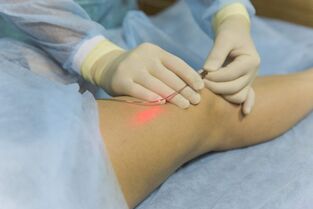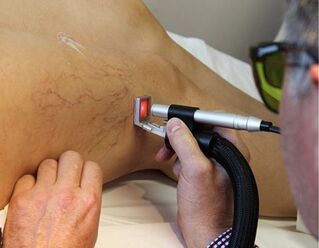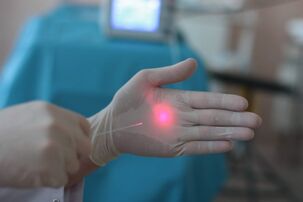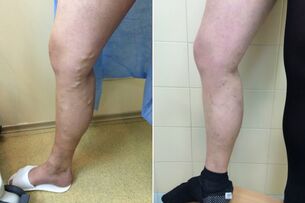A disease in which the veins enlarge, dilate and lose elasticity is known as varicose veins. The result of the disease is not only an obvious cosmetic defect, but also the formation of ulcers, which is accompanied by severe pain. Laser treatment of varicose veins of the lower extremities is one of the most modern and painless methods of eliminating the disease.
Transcript of the procedure

Laser treatment of varicose veins is performed using an ultrasound duplex scanner. In this case, the absorption of laser energy by the hemoglobin of erythrocytes occurs.
As a result, in a few seconds they are converted into thermal energy, the value of which reaches 100 degrees. Blood plasma and its elements boil. This process can be compared to a kind of thermal burn of the walls of the veins, which causes the formation of a blood clot.
After a short time, the veins dissolve and become almost invisible. If the disease is in an advanced form of development, it becomes necessary to repeat the operation. This can be done no earlier than in 30-40 days.
The popularity of the method is due to its inherent advantages. Among the most significant are the following:
- The operation is performed on an outpatient basis. The patient only spends a couple of hours in the clinic.
- The procedure does not require the use of general anesthesia. It is sufficient to anesthetize only the point where the laser catheter is inserted into the vein. Thanks to this, the rehabilitation period is significantly shorter.
- No drug therapy is required after surgery.
- Specialists monitor the progress of the operation using ultrasound monitoring using color Doppler. This ensures the accuracy of the process.
- After surgery, there are no postoperative stitches, punctures or other cosmetic defects on the patient's skin surface.
- The postoperative period does not require bed rest.
- The operation is performed using a single instrument intended for endovascular intervention. Thanks to this, the risk of infection in the body is minimized.
The presence of these and other advantages confirms the effectiveness and efficiency of the procedure for removing varicose veins with a laser.
Indications for laser surgery
Laser treatment of varicose veins is indicated for those patients diagnosed with enlargement of the large and small saphenous veins. In this case, the size of the expansion of the venous orifice does not exceed 1 cm, and the vessels are located evenly, without the formation of numerous bends.
The use of a laser will only be effective when the disease is at an early stage of development.
For whom this method is prohibited

Laser removal of the leg veins is not recommended if the disease is in the second, third or fourth stage of development. The reason is that it is possible for the vein to widen again.
In addition, it should be noted that the laser affects a small area of the vein, which allows you to avoid damage to surrounding tissues. If a person has a large venous lesion, the use of laser therapy will not give the desired result.
If we talk about contraindications to the use of a laser, these can be conditionally divided into 2 groups:
- Absolute.This includes those cases where the use of the laser is strictly prohibited:
- the patient has the possibility of developing thrombophlebitis;
- chronic blood diseases are observed;
- the venous walls show severe lesions.
In these cases, the use of a laser can cause huge blood clots.
- Relative.This group includes contraindications that force laser surgery to be postponed for some time:
- presence of wounds or ulcers on the surface of the patient's skin. They must first be taken care of. Otherwise, the possibility of complications in the postoperative period is not excluded;
- period of pregnancy and lactation. At this time, the female body is weakened, and there is also a heavy load on the lower limbs;
- overweight.
If a patient has contraindications from the first group, experts recommend that he use a different method for the treatment of varicose veins. If there are relative contraindications, it is necessary to eliminate them before using laser therapy.
Preparation

One of the advantages of laser venous treatment is that the patient does not need to go through a long preparatory period.
Preparation before the operation consists in conducting a standard examination, which includes the following manipulations:
- blood and urine analysis, in which the presence of sugar level is determined, the degree of blood coagulability is determined, blood biochemistry is performed, Rh factor and group are determinedblood;
- tests for HIV and the presence of sexually transmitted diseases;
- fluorography;
- with the help of ultrasound, specialists accurately determine the location of the expansion on the leg veins;
- if the patient is very agitated, sedatives are given.
After these manipulations are completed, you can proceed to the operation itself.
Which method to choose
For the treatment of varicose veins, in addition to endovascular laser coagulation, several effective methods can be used. Among the most popular are the following:
- Compression therapy.The essence of the method is to use external compression of the veins, which leads to a decrease in their size. After the operation, it is possible for the vein to increase in length. In most patients, compression therapy is required for the rest of their life. Leg vein laser surgery eliminates this need.
- Phlebectomy.In this case, the vein is surgically disconnected from the general venous system. In this case, the diseased vein is completely removed, which minimizes the re-development of the disease. The disadvantage of this method is the mandatory use of general anesthesia, which leads to an increase in the rehabilitation period up to 3-4 weeks.
- Sclerotherapy.This is an invasive treatment that uses a special foam. The patient is injected with a sclerosing agent, which makes the vessel adhere. The possibility of the development of such postoperative consequences as tissue scarring, necrosis of the skin surface, allergies, migraines and others is not excluded.
- Radio frequency obliteration of the veins.Conducted through the use of radio waves. The catheter is inserted into the vein. Radio waves cause heat to build up and stick to the walls of the veins. This method is contraindicated in patients with pacemakers or defibrillators.

Of all the above methods, EVLO of varicose veins is the most gentle and effective. The final decision on the choice of a method for the treatment of varicose veins can be made only after a thorough general examination and the recommendation of a specialized phlebologist.
Conduct the operation
The removal of varicose veins with a laser is a manipulation that takes no more than 30 minutes. It is performed in several stages:
- In accordance with the previously drawn up map of the patient's veins, the specialist performs local anesthesia where the punctures will be performed;
- a laser-equipped catheter is inserted into the vessel cavity;
- The catheter is gradually advanced into the groin area and then withdrawn. In this case, energy is emitted, which leads to the sealing of the vein.
In order not to damage the mucous membrane of the eye, the patient must first wear protective goggles.
How long
One of the advantages of the laser coagulation method of the vessels on the legs is that the operation itself takes no more than 30 minutes.
After this time, the patient can leave the clinic alone. The short duration of the method is due to the absence of general anesthesia, as well as surgical incisions of the skin surface on the patient's legs.
Postoperative recovery
Laser therapy for varicose veins involves a short postoperative period. In order for it to pass correctly, experts recommend the patient to adhere to the following rules:
- wear compression garments;
- avoids heavy loads on the legs;
- walk in nature as much as possible;
- performs an ultrasound 10-14 days after the operation. This will give the specialist a picture of the state of the human veins at the intervention sites.
Within 2-3 months, the patient is completely cured and is ready to lead his usual life.
Results and possible consequences
If laser vein surgery is performed in a timely manner, the likelihood of the disease returning is very low. The patient returns to his normal, familiar way of life after a few months.
Negative consequences after surgery to remove varicose veins on the legs are very rare. As a rule, this may be a slight pigmentation of the skin in the places where the puncture was performed. It can be eliminated by taking medications.
Average cost of laser treatment
It can be said with certainty that the cost of laser treatment of varicose veins of the legs is the only drawback of the method. It depends on such factors as the degree of development of the disease, the equipment used for the operation, the individual characteristics of the patient and other factors.
Despite the high cost, this method is recognized worldwide as the most effective.
























